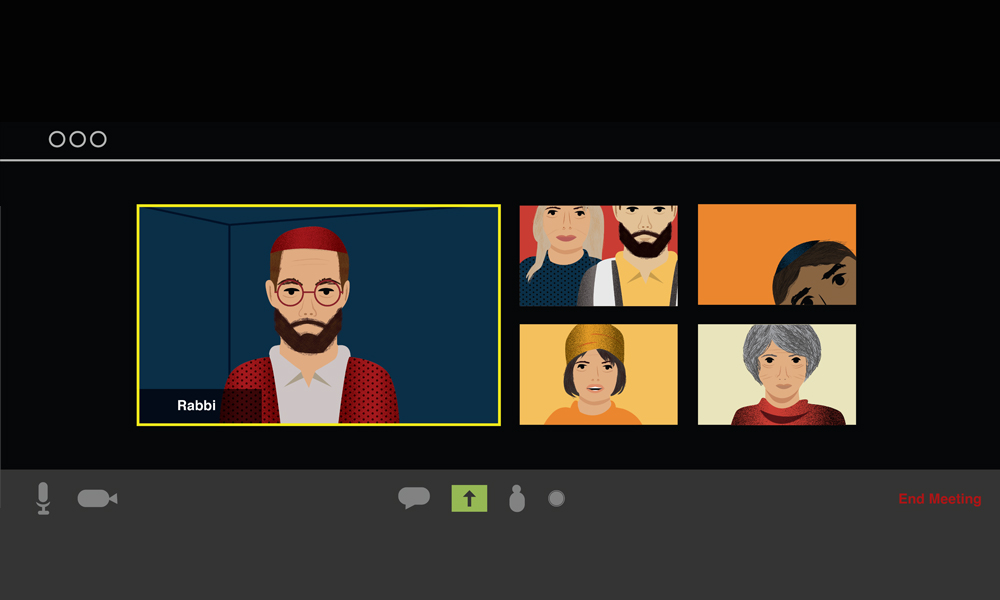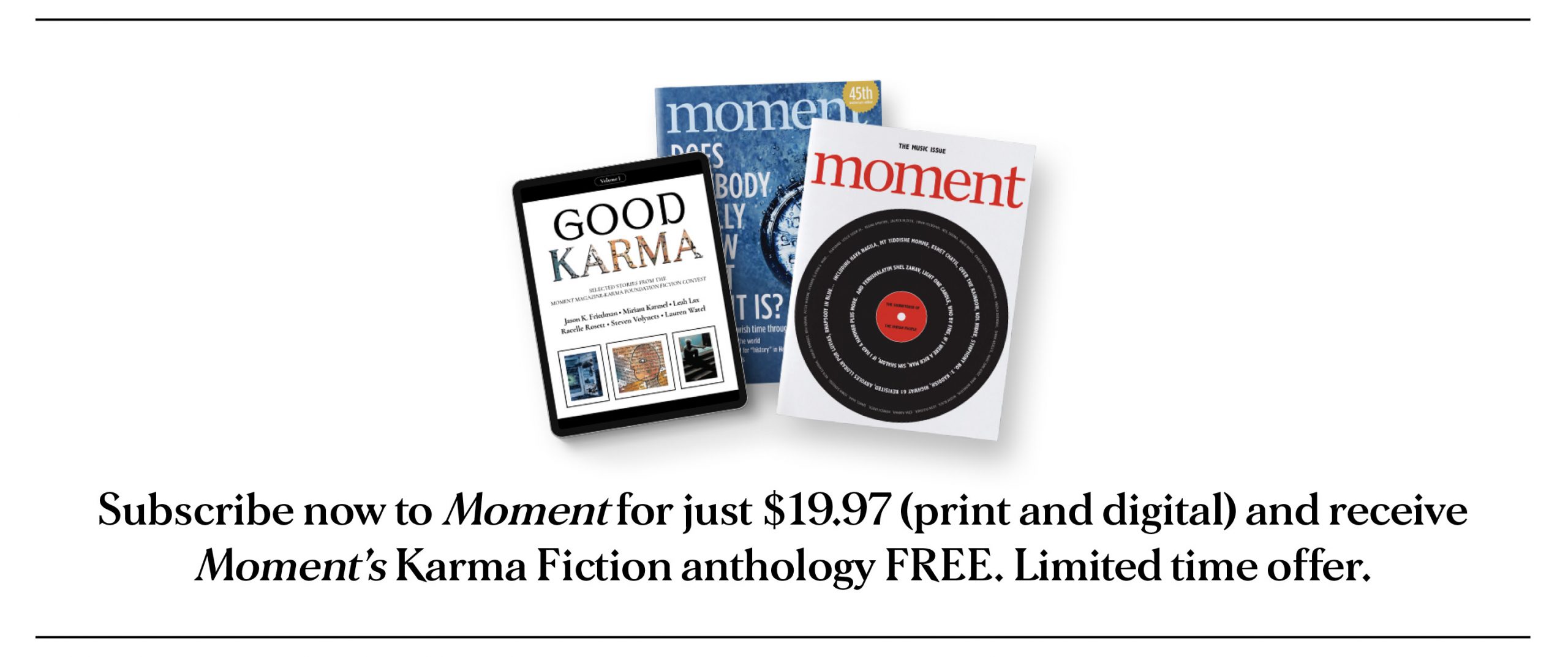In 2018, as synagogues pondered livestreaming some services for the convenience of infirm relatives, we asked the rabbis to contemplate what was surely a distant, speculative future: “What role should virtual presence play in Jewish ritual and community?” Little did we know that there was no need for guesswork. With all now revealed, and our communal crash course in virtual Judaism nearly (we hope) at an end, we have further questions.
INDEPENDENT
During the pandemic, my better three-quarters (Rabbi Dr. Miriam Maron) and I nudged our way into the techno era, investing in equipment we still don’t know how to use so that we could do a webinar, the meaning of which we still do not completely understand, via Zoom, a method of virtual outreach we still are trying to figure out. We’ve learned this is an amazing way to share teachings from our rich tradition across the globe with greater efficiency than a COVID protein. And long after that protein has absconded from memory, this mode of expanding the reaches of Torah will continue to flourish, as the prophets of old foresaw: “For the earth shall be filled with the means by which to know the Glory of Hawayah, as the waters cover the sea” (Habakkuk 2:14). It was Moses who first invented the idea of virtual Judaism, maybe even quantum physics, as is written: “Not with you alone do I enact this covenant…but for those who are standing here with us today…and that are not with us here today” (Deuteronomy 29:13-14).
Rabbi Gershon Winkler
Walking Stick Foundation
Fontana, CA
HUMANIST
When Moment first posed this question in 2018, I was quite bullish on the power of virtual community. Since then, we have learned more than we could possibly have imagined about virtual Judaism. The results are mixed. Like other Jewish organizations, we took as much as possible online: meetings, classes, even funerals. We’ve used YouTube, since our Shabbat and High Holiday programming lends itself better to that platform. It has extended the reach of our small movement beyond anything we could previously imagine. I frequently receive requests from Europe for weekly well-wishes and yahrzeits. Yet being chained to virtual Humanistic Judaism has also become quite wearying. I’m fatigued by green screens and video lighting and by teaching postage-stamp-size people on my laptop. My community is beyond ready to come together in person. YouTube cannot replace an Oneg Shabbat. Zoom cannot provide substantive Jewish education. Condolences offered via a screen are no substitute for a personal embrace. When this is all over, I suspect we will preserve those aspects of virtual Judaism that extend our reach (including to the homebound) and bring our message to ever-widening circles. I expect we will rid ourselves of the rest of it. I’ll welcome the day when that can be our choice.
Rabbi Jeffrey L. Falick
Birmingham Temple Congregation for Humanistic Judaism
Farmington Hills, MI
RENEWAL
I put this question to my congregants, and I wasn’t surprised by the answers. As much as we are eager to get back to in-person services and activities, to hug and sing together and return to the casual normalcy of Kiddush socializing and Friday night meals—still, much is positive. We never had morning minyans before the pandemic, but now they have a strong constituency—if they stay virtual. Evening meetings on Zoom are a boon to congregants who no longer find it easy to drive at night. Disabilities, shyness, bad weather or traffic can all deter participation; online services offer inclusion and convenience. Unexpectedly, shiva minyanim on Zoom seem to be restoring American shiva to a more traditional atmosphere—more solemn, inclusive of far-flung relatives and friends, more focused on the mourner and memories of the deceased than on food and socializing. What will we keep? The shift to a hybrid world of in-person and online Jewish life is not straightforward, and the two might not co-exist as easily as we might hope. As Moses said about worshiping in the wilderness, “We will not know how to worship the Lord until we get there.” On the other hand, the Jewish community has mobilized to learn, explore, change and restructure over this past year with astonishing energy and explosive creativity. Along with this revitalization of Jewish life, let’s take with us the knowledge of our own resilience. While we dwelled in the “narrow places” of the pandemic, we prepared the drums and songs of our redemption.
Rabbi Gilah Langner
Congregation Kol Ami
Arlington, VA
RECONSTRUCTIONIST
Virtual community has been our lifeline. How did they cope in 1918?! Zoom and its cousins offer moral and logistical advantages, which we must maintain even when we revivify our in-person connections. Let’s do better than returning to “normal,” since pre-pandemic norms were unjust, unsustainable and unnecessarily constrained. Today, without driving or flying, we connect clearly with each other. Virtual tools are ideal for committee meetings, Torah studies and other ongoing gatherings, with a minimal ecological footprint. They let far-flung folks access high-quality resources and services, which outside of webinar mode are highly interactive. They’re also inclusive: of those who don’t drive or can’t afford flights, of people with physical or emotional disabilities. Distant relatives now fill shiva families’ screens, and frail elderly people join b’nai mitzvah and wedding celebrations. Those once “too busy,” or diffidently Jewish, now click learning links in their pajamas. There’s no going back on convenience, carbon, quality or communal inclusion. Hugs will be wonderful at periodic in-person gatherings, and digital access must expand further, but “virtual Judaism” will soon be an archaic term. It’s just how we Jew.
Fred Scherlinder Dobb
Adat Shalom Reconstructionist Congregation
Bethesda, MD
REFORM
When we first explored this question in 2018, the livestreamed Shabbat service, b’nai mitzvah or shiva minyan was considered pioneering. They are now ubiquitous. The pandemic pushed communal Jewish life into online spaces. I wrote then that using technology to preserve and deepen relationships can be “a powerful tool to create intense moments of connection and transcendence.” The past year has proven this to be true. While physically distant, many communities have become spiritually closer.
Two lessons emerge from the pandemic about what’s important. First, accessibility. Many communities found that people who had trouble attending in person could be fully present in online spaces. In mine, a dear member who had been battling severe depression has become a regular online Shabbat worshipper and community event participant. Their ability to be in community aids their healing process without pushing them too far, too fast.
Second, good teaching. Moving Jewish learning online challenged educators to return to their essential philosophies about teaching, learning and building relationships between learners. I hope educational leaders will use those beliefs as they re-envision Jewish learning post-pandemic. If we can redesign Jewish participation and observance in ways that advance these lessons learned, our communities will be stronger for it.
Rabbi Dr. Laura Novak Winer
Fresno, CA
CONSERVATIVE
Moe, age 90, died on Thanksgiving, leaving his wife and five children. After the week of shiva, I noticed that Moe’s widow came to our virtual minyan every evening, as did their five adult children. From North Carolina to Massachusetts, the family gathered at a virtual Ma’ariv service to check in, to support one another and to recite Mourner’s Kaddish. Jolene died in late January; her daughters, who live and attend congregations in different cities, come “home” to our minyan every evening to recite Kaddish together for their mother, bonding, mourning and growing. Lastly, consider Rebecca, a mother of an infant. Rebecca’s own mother died a month ago. Rebecca, her husband and their new baby join us every evening and morning; the online minyan allows easy access to prayer and community.
Each of these stories—and many more—have death and Kaddish as common threads, but they are about sharing life, prayerful experience and community. For my congregants, the online minyan is not just about saying Kaddish but about connecting with family, childhood and their Jewish upbringing. Our online minyanim have made an enormous difference for many. While I don’t know what we will do once it is safe to gather in person, we need to ask how we may best continue supporting our congregants and their loved ones in times of need.
Rabbi Amy Wallk Katz
Temple Beth El
Springfield, MA
MODERN ORTHODOX
Virtual prayers and religious programs have been lifesavers. Zoom has helped us get through an impossible moment of isolation, and we will be eternally grateful. However, virtual presence is not as impactful or as emotionally fulfilling as personal presence. I bet that after the pandemic, people will much prefer to go to shul, weddings, simchas and funerals in person.
What will remain of virtual Judaism? Liberal Jews will take continuing advantage of services more liturgically exciting or with better sermons than their home synagogues. All institutions will be able to bring in speakers or programs from a richer ensemble of choices and be open to audiences coming from more places. We also have learned from lockdowns that services can be shorter, with less talking and distraction. Weddings and simchas can be more modest in size, without over-elaborate finery and menus. Shiva can be regulated so fewer people come at one time, resulting in more personal contact and intimate, substantive conversation.
I hope vaccinations will become universal and restrictions will no longer be necessary. But if the threat persists and we must continue with masks, distancing and all the current disciplines, let us hope that all Jews can learn how to be permanently observant, on a daily basis, if that is what is needed to protect life.
Rabbi Yitz Greenberg
J.J. Greenberg Center for Jewish Life/Hadar Institute
New York, NY
ORTHODOX
One thing won’t happen in the Orthodox community: any major change in the way we lead our communal lives. We are, as a community, addicted to one another. Our cycles of interacting live with other people can’t be replaced halachically with any technological fix. That said, I can think of three areas of lasting impact from a year or more spent, as they say in Yiddish now, ausgezoomt.
1) Except for the parts of the community that don’t use the internet, people unable to attend their usual neighborhood Torah classes have gotten used to the idea of “positive Torah surfing.” Organizations like the Orthodox Union outdid themselves in providing daily programming. The value of the local shiur won’t change, but people will also help themselves to Torah programming from all over the world.
2) Almost overnight, employers gave up their objections to telecommuting. That’s going to be a big boon to aliyah. Thousands of families who were sitting on the fence about making the move will be able to take their skills to Israel and work from there.
3) The stranglehold that extremist elements on U.S. college campuses have on our youth may be partially loosened. Many students won’t go back to four years in a campus dorm, or to classrooms where they are often at the mercy of particular professors in learning to despise Israel. The spell that a good professor can have live in the classroom is not maintained when people are mostly engaged in distance learning. It’s difficult to be an openly pro-Israel student on many campuses. This may give us a few of our own students back.
Rabbi Yitzchok Adlerstein
Cross-Currents
Los Angeles, CA
CHABAD
“Virtual” accommodations during the COVID-19 pandemic are indeed something of a mixed bag. On the one hand, communities have been kept together better—albeit virtually, which causes issues regarding Shabbat, etc.—and participation in Torah learning and public weekday events has even been enhanced. Lectures saw more people tune in from more places. Organizations could procure higher-profile speakers without travelling times and other expenses.
At the same time, programming now all but requires a “comfort” component, which, if not retooled, could erode community participation in the longer term, even within more geographically close-knit and observant groups. The need to actually attend local learning or prayer services will be hard to renew when life returns to normal, with so many now satisfied with content enjoyed alone in the comfort of their homes.
I hope the pandemic’s end will bring a return to previous if not greater levels of in-person attendance. While new methods of connection have been successful and even become acceptable in business settings, Jewish life—whenever possible—calls for being in the room and thus in the spirit, in order for the magic of our traditions as well as communal cohesion to be actually effective.
Rabbi Levi Shemtov
Executive Vice President
American Friends of Lubavitch
Washington, DC
SEPHARDIC
I see no clear line between “before” and “after”—maybe because I have worked with an online community since 2009. The “after” simply allows us to see with greater clarity what was there “before.” For instance: People wanted to attend services but could not, because of sickness, work or lack of the right fit in their vicinity. People wanted to study, but there were no good classes available where they lived. Distance kept relatives from life-cycle events, joyous or mournful, and grandparents from their grandchildren’s school presentations.
One problem unique to Judaism is that of converts, who need to immerse in a mikveh in the presence of a rabbinical court to complete the process of conversion. Pre-pandemic, many of those choosing to become Jews were stuck before the final stage, because they could not afford to travel to where the rabbis were, and rabbis would not come to them. During the last year, new virtual communities were formed across the Jewish world, knowledge-thirsty learners discovered new opportunities, and families found virtual ways to connect. What about conversions? I cannot start to describe the joy of my fellow-Jews-by-choice in Brazil, Trinidad, Colombia and many other places as the virtual Bet Din welcomed them to the Jewish people.
There is no doubt that we crave and need physical connection and presence, but now that the world has discovered the possibilities of virtual connection, I believe that all the elements of virtual Judaism will remain, and that many more will be added.
Rabbi Haim Ovadia
Torah VeAhava
Potomac, MD














